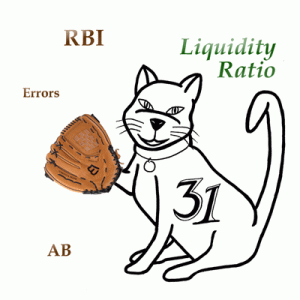 If you are a baseball player (or fan!) you know your Batting Average cold.
If you are a baseball player (or fan!) you know your Batting Average cold.
Any quarterback worth his salt religiously works to keep up his pass completion ratio (COMP).
Are you giving the same attention to your business?
Do you know and understand the key ratios that indicate if you are Tony Romo on a good game day or bad?
We’ve established that you can calculate and keep track of statistics (see Exhibit A above). It is your business, so you must want it to be successful. All you need are a few simple tools to do it.
Fear not! It’s as easy as catching an infield fly ball, taking a knee or scoring on an empty net.
Calculate (and understand) your company’s liquidity ratio in 3 easy steps.
Step 1: Liquidity Ratio in Plain English
Quite simply, this ratio tells us the ability of a company to pay off its short-term debts and obligations. (See that was easy, wasn’t it?)
Why should you care?
First, if your company does not have sufficient assets to meet its obligations, you may be unable to purchase necessary supplies or cover payroll. It might cost you clients, force you into shutting down or even to file bankruptcy. That would be bad – like a cat puking a hairball into your new shoes bad.
The Liquidity Ratio is essentially an easy early warning signal for cat hairballs potential problems meeting obligations.
Second, if you are seeking to obtain a line of credit or loan with a financial institution, they will review this ratio. If the number is not good enough, you will not be approved.
Step 2: Calculating Your Current Liquidity Ratio
Current Liquidity Ratio = (Current Assets) / (Current Liabilities)
Pretty simple right?
Not sure what you should include in your current assets or liabilities? Some examples of current assets include: cash and equivalents, short-term investments, prepaid expenses, accounts receivable and inventory.
Examples of current liabilities include: accounts payable, short term loans and unpaid payroll.
Want to see it in action with some real numbers?
Current Assets = $50,000
Current Liabilities = $40,000
Current Liquidity Ratio = 1.25
Step 3: What Is a Good Number?
This is not a one size fits all answer.
Let’s go back to baseball for a minute. No one expects the pitcher to have a stellar batting average. However, if you are the pinch hitter, you better be above 300!
At a minimum, you want a ratio higher than 1, as that means your company’s assets are sufficient to cover all your liabilities. For most industrial companies a ratio of about 1.5 is good.
If your company’s current assets are very liquid, say 80% cash, being close to 1 is not a concern. However, if your current assets are heavily weighted to prepaid expenses and inventory, you need to consider that if an unexpected situation arises, you may have to sell at a heavy discount. If that describes your company, a ratio of 1.5 or higher is desirable.
One word of warning: this number can actually be too high. Your company might be the business version of people stuffing cash into their mattresses. Yes, you might be one of those crazy hoarders!
A business is intended to wisely invest and grow capital, not hoard it. If you have anything over a 3, you should be taking a hard look at your investment strategy and asking yourself why are you sitting on all this cash?
Am I living in numbers geek la-la land? Do you believe pro athletes don’t care about their stats? Or will you be setting up your own biz stats scoreboard today?

